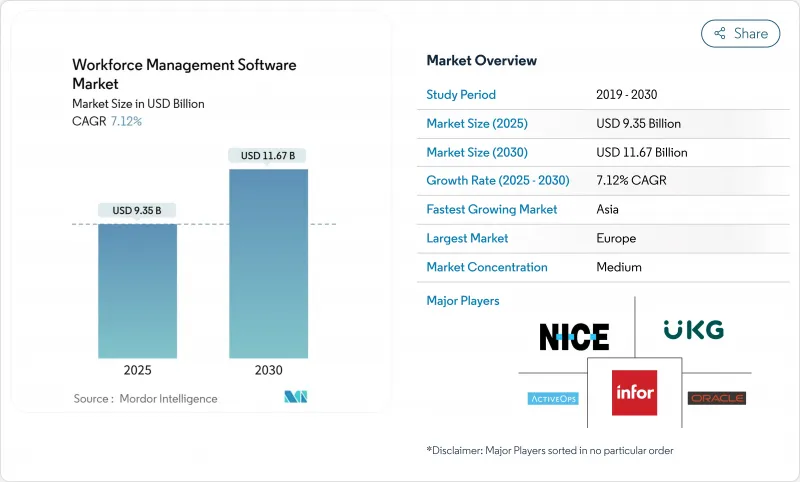
|
시장보고서
상품코드
1836436
인력 관리 소프트웨어 : 시장 점유율 분석, 산업 동향, 통계, 성장 예측(2025-2030년)Workforce Management Software - Market Share Analysis, Industry Trends & Statistics, Growth Forecasts (2025 - 2030) |
||||||
인력 관리 소프트웨어 시장은 2025년에 93억 5,000만 달러에 달하고, CAGR 7.12%를 나타내 2030년에는 116억 7,000만 달러에 이를 것으로 예측됩니다.

성장의 배경은 인건비 시각화, 컴플라이언스 자동화, 인력 관리 코어에 인공지능 도입 등 노동력 최적화를 일상적인 관리에서 이사회 수준의 우선사항으로 끌어올리는 명확한 성과가 있습니다. 하나의 플랫폼에서 예측 스케줄링, 실시간 급여 계산 및 분석을 연결하는 공급업체는 직원 경험의 생태계로 이어지는 수요를 활용합니다. 하이브리드 워크와 원격 워크는 언제든지 액세스할 수 있어야 하기 때문에 클라우드 배포가 새로운 지출의 대부분을 차지하고 모바일 인터페이스는 현장 소매업부터 헬스케어에 이르기까지 최전선 부문에서 채용이 진행되고 있습니다. 동시에 생체인증과 예측분석이 대기업의 잔업시간을 2자리 줄이는 데 도움이 되고, 합리화된 노동 오케스트레이션이 직접적인 이익 레버리지임을 최고 재무 책임자에게 납득시키고 있습니다.
세계의 인력 관리 소프트웨어 시장 동향과 인사이트
AI를 활용한 노동 예측 파일럿에 의해 EU의 변화제 산업에서의 도입이 가속
예측 스케줄링을 시도한 유럽 공장에서는 특히 수요가 매주 변동하는 자동차 및 소비재의 부문에서 생산창을 계약하면서 잔업대를 최대 25% 삭감하고 있습니다. Paycor의 2024 AI 어시스턴트는 이러한 예측을 명부 작성에 직접 통합하여 플래너에 필요한 인원 수의 2주 보기를 제공합니다. 경영진은 예측된 오더, 스킬 프로파일, 임금 수준을 하나의 알고리즘으로 상호 참조함으로써 직전의 대리점 노동을 억제하고 공급체인 충격시의 마진 회복력을 강화할 수 있다고 지적하고 있습니다. 유럽의 노동 시장이 더욱 급박하고 있는 가운데, 이사회는 AI 파일럿 사업에 대한 실험적 예산이 아니라 생산성 KPI에 연동한 핵심 업무의 업그레이드로서 자금을 제공합니다. 결과적으로 의사 결정주기가 빨라지고 예기치 않은 가동 중지 시간이 분명히 줄어들고 AI 스케줄링은 틈새 부가 기능에서 중간 규모 공장의 기본 기능으로 밀어 올립니다.
동남아시아의 다거점 소매 체인에서 모바일 첫 WFM의 보급
인도네시아, 태국, 필리핀의 소매 그룹은 실시간 입장자 수, 날씨 이동 및 지역 축제에 맞게 인력 배치를 재조정하는 모바일 노동력 앱을 배포합니다. Rippling의 2025년 3월 오프라인 키오스크 기능은 광대역 없이 클럭 인을 가능하게 하고, 2차 도시에서 SaaS의 배포를 방해하는 연결 갭을 해결했습니다. 본부는 수백 개의 상점에 걸쳐 통일된 인건비 대시보드를 획득하고, 경영진은 한때 스프레드시트에 갇혀 있던 생산성 지표를 벤치마킹할 수 있습니다. 초기 도입 기업은 트래픽이 급증했을 때 플로어 매니저가 변화를 즉시 전환할 수 있기 때문에 전환율이 1자리 퍼센트 상승했다고 보고하고 있습니다. ASEAN 회원국간에 규제가 다양화되는 가운데 현지 노동규칙을 통합하는 동시에 기업의 재무팀에 통합분석을 제공하는 모바일 솔루션은 국경을 넘는 소매기업에 급속히 보급되고 있습니다.
독일 중견 제조업의 레거시 MES/ERP 통합 비용
바덴-뷔르템베르크의 전문 제조업체는 최신 API가 없는 노후화된 제조 실행 시스템을 운영하고 있으며, 클라우드 스케줄링 엔진과 연동할 때 연간 IT 예산의 최대 20%를 소비하는 커스텀 커넥터를 강요하고 있습니다. 경영진은 딜레마에 직면하고 있습니다. 실시간 노동 오케스트레이션에 의한 효율 업은 분명하지만, 특주 미들웨어와 데이터 품질의 개선이 더해지면 투자 회수까지의 기간이 길어져 버립니다. 그 결과, 티아완의 자동차 부품 제조업체는 업그레이드를 진행하고 있지만, 중소의 공구 제조업체는 업그레이드를 앞두고 업계 내 생산성 격차가 확대되고 있습니다. 독일 시장 점유율을 목표로 하는 벤더는 저코드 통합 허브와 성공 보상형 가격 설정으로 대응하여 예산의 위험을 줄이고 있지만, 광범위한 전환은 장기적인 과제입니다.
보고서에서 분석된 기타 성장 촉진요인 및 억제요인
- GCC의 헬스케어 인력 부족이 클라우드 기반 WFM 투자에 박차
- 블록체인 기반의 토큰화의 출현이 아시아에 있어서의 부동산의 프랙셔널 거래 가능
- 중국의 데이터 거주규칙이 외국 SaaS형 WFM 전개를 제한
부문 분석
엔터프라이즈는 인력 개혁을 기술 조달이 아닌 전반적인 변경 관리 여행으로 간주하므로 서비스 매출은 성숙한 소프트웨어 라이선스를 능가하며 CAGR 12.5%를 나타낼 전망입니다. 도입 워크숍, 역할 기반 교육, 지속적인 최적화 프로그램이 여러 해 계약을 지원할 수 있게 되었으며, 벤더는 장기적인 고문으로 변모하고 있습니다. 이사회가 영업 지출 예산을 자본 지출 항목이 아닌 경상적인 가치 실현에 할당하기 때문에 인력 관리 소프트웨어 서비스 시장 규모는 크게 확대될 것으로 예측됩니다. 인사 컨설팅을 컴플라이언스 감사에 번들링하는 파트너 에코시스템은 구매자가 성과에 대한 책임 있는 소유자를 요구하기 때문에 보다 신속하게 거래를 이행하고 있습니다.
인력 관리, 스케줄링, 애널리틱스를 통합한 통합 제품군은 과거에는 최고의 블리드 포인트 솔루션을 선호했던 통합 오버헤드를 줄여 소프트웨어가 62%의 수익을 유지합니다. 공급업체는 머신러닝 모듈과 사전 구축된 규제 컨텐츠를 통합하여 점착성을 높입니다. 이 모델은 거친 이자율을 높이고 스위칭 비용을 높이며 인력 관리 소프트웨어 시장이 기능의 폭과 깊이를 계속 평가할 수 있도록 보장합니다. 플랫폼 규모와 하이터치 자문 서비스의 균형을 이루는 공급자는 업데이트 주기에서 우수합니다.
인력 관리는 여전히 기본이지만, 경영진이 소급적인 컴플라이언스 로그가 아니라 미래를 향한 인사이트를 요구하고 있기 때문에 인력 애널리틱스가 CAGR 14%라는 가장 높은 수치를 나타낼 전망입니다. 분석 엔진은 현재 내부 변화 데이터와 외부 신호(경제 지표, 날씨 피드, 휴일 캘린더)를 통합하여 2% 포인트 이내의 정확도로 인력 수요를 예측했습니다. 이직률 예측 점수를 활용하고 있는 부문에서는 채용비를 2자리대 전반으로 삭감할 수 있었습니다고 보고하고 있어 애널리틱스가 비용 억제의 테코로서 유효한 것이 실증되고 있습니다. 대시보드가 노동 효율 개선을 영업 이익률 개선에 직접 연결하면 경비 정당화가 쉬워집니다.
인력 관리 소프트웨어 시장 점유율은 27%로 계속 높지만, 이는 세계 각국의 규제 당국이 기록 유지 및 급여 계산의 의무화를 강화하고 있기 때문입니다. 생체 인식 클럭 인은 버디 펀치를 억제하고 AI 비디오 인증은 분산 인력에서 스푸핑을 방지합니다. 스케줄링 모듈은 기술 인증, 노동법 상한, 직원의 희망을 동시에 고려하는 오케스트레이션 레이어로서의 역할을 수행하고 있습니다. 조직이 성과 기반 스케줄링으로 전환함에 따라 애널리틱스 타워에 통합된 피로 관리는 직장 안전과 고용주 브랜드의 공정성을 높입니다.
인력 관리 소프트웨어 시장은 구성 요소(소프트웨어, 서비스), 소프트웨어 유형(인력 관리, 인력 스케줄링 등), 배포 모드(클라우드, On-Premise), 조직 규모(대기업, 중소기업), 최종 이용 산업(은행, 금융서비스 및 보험(BFSI), 소비재 및 소매, 기타), 지역별로 구분됩니다. 시장 예측은 금액(달러)으로 제공됩니다.
지역별 분석
유럽은 엄격한 노동법제와 AI 주도 예측 엔진의 조기 도입에 힘입어 2024년 세계 수익의 30%를 차지했습니다. 경영진은 각국의 잔업 기준, 노동 협약, GDPR(EU 개인정보보호규정) 프로토콜을 스케줄러 로직에 직접 통합하는 플랫폼을 높이 평가했습니다. 그럼에도 불구하고 알고리즘 관리는 노동 조합 감시하에 있으며 프랑스와 스웨덴의 노동 단체는 투명성 확보를 요구하고 있습니다. 독일에서는 통합 장애물에서 미텔 스탠던드 기업의 도입이 지연되고 있지만, 자동차 및 제약의 선도적인 콩그로말리트는 첨단 모듈을 시험적으로 도입하고 있으며, 장기적인 수요를 시사하고 있습니다.
아시아태평양은 2030년까지 연평균 복합 성장률(CAGR)이 16.1%를 나타내 가장 빠르게 성장하는 지역입니다. 중국에서는 현지 벤더가 국유기업을 획득하기 위해 체류자격을 이용하는 반면 외자계 공급자는 클라우드 벤처 합작을 협상하고 있습니다. 동남아시아 소매업은 모바일 퍼스트 SaaS에서 레거시 시스템을 구축하고 호주 법정 보고 의무화는 통합 스위트로 조직을 유도합니다. 동시에 신흥 시장에서는 광대역 격차가 실시간 서비스를 제약하고 있지만 세계은행이 지원하는 광섬유 프로젝트가 2019년 이후 1억 6,000만 명의 신규 유저를 커버해 2027년까지 제약이 완화될 전망입니다.
북미는 지속적인 기업 근대화와 AI 스케줄링 신흥 기업의 혁신 파이프라인을 통해 견조한 성장을 유지하고 있습니다. 브라질과 콜롬비아의 물류 허브는 급여 부정을 억제하기 위해 생체인증 타임클럭을 도입하고 있으며, 연결성과 컴플라이언스의 틀이 안정되면 남미의 가능성을 보여줍니다. 중동에서는 비전 발표와 석유 수입 증가로 병원 확장과 설계 단계에서 인력 오케스트레이션을 통합한 스마트 시티의 파일럿에 자금이 공급되어 지역 투자가 인프라로서 최신 WFM을 상정하게 되어 있는 것으로 나타났습니다.
기타 혜택
- 엑셀 형식 시장 예측(ME) 시트
- 3개월간의 애널리스트 서포트
목차
제1장 서론
- 조사 전제조건과 시장 정의
- 조사 범위
제2장 조사 방법
제3장 주요 요약
제4장 시장 상황
- 시장 개요
- 시장 성장 촉진요인
- AI를 활용한 노동 예측 파일럿에 의해 EU의 변화제 산업에서의 도입이 가속
- 동남아시아의 다거점 소매 체인에 있어서의 모바일 퍼스트 WFM의 보급
- GCC 헬스케어 인력 부족이 클라우드 기반 WFM 투자에 박차
- 호주 및 뉴질랜드의 실시간 급여세보고 의무화로 통합형 스위트가 증가
- 남미의 물류 거점에 있어서의 생체 인증 인력 관리가 급여 부정을 억제
- 시장 성장 억제요인
- 독일의 중견 제조업에 있어서의 레거시 MES/ERP 통합 코스트
- 중국의 데이터 거주 규칙이 해외의 SaaS형 WFM 도입을 제한
- 신뢰성이 낮은 광대역 인프라가 사하라 이남의 아프리카에서의 클라우드 도입을 방해
- 알고리즘에 의한 변화 스케줄링에 대한 프랑스 노동 조합의 반발
- 밸류체인 분석
- 규제의 전망
- 기술적 전망
- Porter's Five Forces 분석
- 신규 참가업체의 위협
- 구매자의 협상력
- 공급기업의 협상력
- 대체품의 위협
- 경쟁 기업 간 경쟁 관계
- 시장의 거시 경제 동향 평가
- 투자 분석(자본 흐름 및 벤처 캐피털 자금 조달 동향)
제5장 시장 규모·성장 예측(금액)
- 구성 요소별
- 소프트웨어
- 서비스별
- 소프트웨어 유형별
- 인력 관리
- 인력 스케줄링
- 인력 분석
- 결근 및 휴가 관리
- 피로도 및 업무 관리
- 배포 모드별
- 클라우드
- On-Premise
- 조직 규모별
- 대기업
- 중소기업
- 업종별
- BFSI
- 소비재 및 소매
- 자동차
- 에너지 및 유틸리티
- 헬스케어
- 제조
- IT 및 통신
- 물류 및 운송
- 기타 산업
- 지역별
- 북미
- 미국
- 캐나다
- 멕시코
- 유럽
- 영국
- 독일
- 프랑스
- 이탈리아
- 스페인
- 북유럽
- 기타 유럽
- 아시아태평양
- 중국
- 인도
- 일본
- 한국
- 동남아시아
- 기타 아시아태평양
- 남미
- 브라질
- 아르헨티나
- 칠레
- 기타 남미
- 중동
- 아랍에미리트(UAE)
- 사우디아라비아
- 튀르키예
- 기타 중동
- 아프리카
- 남아프리카
- 나이지리아
- 기타 아프리카
- 북미
제6장 경쟁 구도
- 시장 집중도
- 전략적 동향
- 시장 점유율 분석
- 기업 프로파일
- ActiveOps PLC
- NICE Ltd.
- Infor Group
- Oracle Corporation
- UKG Inc.
- SAP SE
- ADP LLC
- Blue Yonder Group, Inc.(Panasonic)
- IBM Corporation
- Workday Inc.
- Reflexis Systems Inc.(Zebra)
- SISQUAL Workforce Management, Lda
- ServiceMax Inc.
- Atoss Software AG
- Mitrefinch Ltd(Advanced)
- Deputy Group Pty Ltd
- 7shifts Employee Scheduling Software Inc.
- Sage Group plc
- Roubler Australia Pty Ltd
- tamigo ApS
- Verint Systems Inc.
- ClickSoftware(Salesforce Field Service)
- Ceridian HCM Holding Inc.
- Humanity(TCP Software)
제7장 시장 기회와 전망
KTH 25.10.27The workforce management software market is valued at USD 9.35 billion in 2025 and is projected to reach USD 11.67 billion by 2030, expanding at a 7.12% CAGR.

Growth stems from clear gains in labor-cost visibility, automated compliance, and the infusion of artificial intelligence into time-and-attendance cores, all of which elevate workforce optimization from routine administration to a board-level priority. Vendors that link predictive scheduling, real-time payroll, and analytics in one platform are capitalizing on demand for connected employee-experience ecosystems. Cloud deployment dominates new spending because hybrid and remote work require anytime access, while mobile interfaces unlock adoption in frontline sectors ranging from on-site retail to healthcare. Simultaneously, biometric authentication and predictive analytics help large enterprises cut overtime by double-digit percentages, convincing chief financial officers that streamlined labor orchestration is a direct profit lever.
Global Workforce Management Software Market Trends and Insights
AI-driven Labor Forecasting Pilots Accelerate Adoption in EU Shift-based Industries
European factories that trial predictive scheduling have lowered overtime outlays by up to 25% while tightening production windows, especially in automotive and consumer goods segments where demand fluctuates weekly. Paycor's 2024 AI assistant embeds these forecasts directly into roster creation, giving planners a two-week view of required headcount. Management teams note that cross-referencing predicted orders, skill profiles, and wage tiers within one algorithm curtails last-minute agency labor and bolsters margin resilience during supply-chain shocks. As European labor markets tighten further, boards are funding AI pilots not as experimental budgets but as core operational upgrades tied to productivity KPIs. The result is faster decision cycles and demonstrable reductions in unplanned downtime, pushing AI scheduling from a niche add-on to a default capability in midscale factories.
Mobile-first WFM Penetration in Southeast Asian Multi-site Retail Chains
Retail groups in Indonesia, Thailand, and the Philippines are rolling out mobile workforce apps that re-align staffing levels with real-time footfall, weather shifts, and regional festivals. Rippling's March 2025 offline kiosk functionality allows clock-in without broadband, solving the connectivity gap that has stalled SaaS rollouts in secondary cities. Headquarters gain unified labor-cost dashboards across hundreds of stores, letting executives benchmark productivity metrics that were once trapped in spreadsheets. Early adopters report single-digit percentage increases in conversion rates because floor managers can swap shifts on the fly when traffic spikes. As regulations diverge across ASEAN member states, mobile solutions that embed local labor rules while feeding consolidated analytics to corporate finance teams are rapidly becoming table stakes for cross-border retailers.
Legacy MES/ERP Integration Costs among German Mittelstand Manufacturers
Specialty manufacturers in Baden-Wurttemberg operate aging manufacturing execution systems that lack modern APIs, forcing custom connectors that swallow up to 20% of the annual IT budget when linking to cloud scheduling engines.Management faces a dilemma: the efficiency upside of real-time labor orchestration is clear, yet payback horizons lengthen when bespoke middleware and data-quality remediation are added. Consequently, tier-one automotive suppliers proceed, while smaller toolmakers postpone upgrades, widening intra-sector productivity disparities. Vendors seeking German market share are responding with low-code integration hubs and success-based pricing to de-risk budgets, but widespread conversion remains a long-run challenge.
Other drivers and restraints analyzed in the detailed report include:
- GCC Healthcare Staffing Shortages Spur Cloud-based WFM Investments
- Emergence of Blockchain-Based Tokenization Enabling Fractional Real-Estate Deals in Asia
- China's Data Residency Rules Limiting Foreign SaaS WFM Deployments
For complete list of drivers and restraints, kindly check the Table Of Contents.
Segment Analysis
Services revenue is on track for a 12.5% CAGR, outpacing mature software licenses, as enterprises view successful workforce transformation as a holistic change-management journey rather than a technology procurement. Implementation workshops, role-based training, and continuous optimization programs now anchor multi-year contracts, converting vendors into long-term advisers. The workforce management software market size for services is projected to expand materially as boards allocate operating-expenditure budgets toward recurring value realization rather than capital-expenditure line items. Partner ecosystems that bundle HR consulting with compliance audits are closing deals faster because buyers seek one accountable owner for outcomes.
Software retains 62% revenue because unified suites that integrate attendance, scheduling, and analytics reduce the integration overhead that once favored best-of-breed point solutions. Vendors embed machine learning modules and pre-built regulatory content to increase stickiness. This model shores up gross margins and raises switching costs, ensuring that the workforce management software market continues to prize breadth and depth of functionality. Providers that balance platform scale with high-touch advisory services are pulling ahead in renewal cycles.
Time and Attendance remains foundational, yet Workforce Analytics is registering the strongest 14% CAGR as executive teams demand forward-looking insights rather than retrospective compliance logs. Analytics engines now merge internal shift data with external signals-economic indices, weather feeds, and holiday calendars-to predict staffing demand within 2-percentage-point accuracy. Segments that harness predictive turnover scores report reducing recruitment spend by low-double-digit percentages, validating analytics as a cost-containment lever. Expense justification is easier when dashboards tie labor efficiency gains directly to operating-margin improvements.
The workforce management software market share for Time and Attendance stays compelling at 27% because regulators worldwide tighten record-keeping and payroll mandates. Biometric clock-in curbs buddy punching, while AI video verification guards against spoofing in dispersed workforces. Scheduling modules increasingly serve as orchestration layers that weigh skill credentialing, labor-law ceilings, and employee preferences simultaneously. As organizations move toward outcome-based scheduling, fatigue management embedded in analytics towers elevates workplace safety and employer-brand equity.
Workforce Management Software Market is Segmented by Component (Software, Services), Software Type (Time and Attendance Management, Workforce Scheduling, and More), Deployment Mode (Cloud, On-Premises), Organization Size (Large Enterprises, Smes), End-Use Industry (BFSI, Consumer Goods and Retail, and More), and by Geography. The Market Forecasts are Provided in Terms of Value (USD).
Geography Analysis
Europe contributes 30% of 2024 global revenue, underpinned by stringent labor legislation and early adoption of AI-led forecasting engines. Executives appreciate platforms that bake national overtime thresholds, works-council agreements, and GDPR protocols directly into scheduler logic. Nevertheless, algorithmic management faces union scrutiny, with French and Swedish labor groups pushing for transparency safeguards. Germany's integration hurdles slow uptake among Mittelstand firms, yet large automotive and pharma conglomerates continue to pilot advanced modules, signaling long-run demand.
Asia-Pacific is the fastest mover with a 16.1% CAGR to 2030. In China, local vendors exploit residency rules to win state-owned enterprises, while foreign providers negotiate joint cloud ventures to remain relevant. Southeast Asian retailers leapfrog legacy systems via mobile-first SaaS, and Australian statutory reporting mandates coax organizations toward integrated suites. Simultaneously, broadband gaps in emerging markets constrain real-time services, but World Bank-backed fiber projects covering 160 million new users since 2019 are expected to ease constraints by 2027.
North America keeps a solid growth clip through sustained enterprise modernization and an innovation pipeline of AI scheduling startups. Logistics hubs in Brazil and Colombia deploy biometric time clocks to curb payroll fraud, indicating South American potential when connectivity and compliance frameworks stabilize. In the Middle East, Vision announcements and elevated oil revenues fund hospital expansions and smart-city pilots that embed workforce orchestration at the design phase, demonstrating that regional investments increasingly assume modern WFM as infrastructure.
- ActiveOps PLC
- NICE Ltd.
- Infor Group
- Oracle Corporation
- UKG Inc.
- SAP SE
- ADP LLC
- Blue Yonder Group, Inc. (Panasonic)
- IBM Corporation
- Workday Inc.
- Reflexis Systems Inc. (Zebra)
- SISQUAL Workforce Management, Lda
- ServiceMax Inc.
- Atoss Software AG
- Mitrefinch Ltd (Advanced)
- Deputy Group Pty Ltd
- 7shifts Employee Scheduling Software Inc.
- Sage Group plc
- Roubler Australia Pty Ltd
- tamigo ApS
- Verint Systems Inc.
- ClickSoftware (Salesforce Field Service)
- Ceridian HCM Holding Inc.
- Humanity (TCP Software)
Additional Benefits:
- The market estimate (ME) sheet in Excel format
- 3 months of analyst support
TABLE OF CONTENTS
1 INTRODUCTION
- 1.1 Study Assumptions and Market Definition
- 1.2 Scope of the Study
2 RESEARCH METHODOLOGY
3 EXECUTIVE SUMMARY
4 MARKET LANDSCAPE
- 4.1 Market Overview
- 4.2 Market Drivers
- 4.2.1 AI-driven Labor Forecasting Pilots Accelerate Adoption in EU Shift-based Industries
- 4.2.2 Mobile-first WFM Penetration in Southeast Asian Multi-site Retail Chains
- 4.2.3 GCC Healthcare Staffing Shortages Spur Cloud-based WFM Investments
- 4.2.4 Real-time Payroll Tax Reporting Mandates in Australia and New Zealand Boost Integrated Suites
- 4.2.5 Biometric Time and Attendance to Curb Payroll Fraud in South American Logistics Hubs
- 4.3 Market Restraints
- 4.3.1 Legacy MES/ERP Integration Costs among German Mittelstand Manufacturers
- 4.3.2 China's Data Residency Rules Limiting Foreign SaaS WFM Deployments
- 4.3.3 Unreliable Broadband Infrastructure Hindering Cloud Adoption in Sub-Saharan Africa
- 4.3.4 French Union Pushback Against Algorithmic Shift Scheduling
- 4.4 Value Chain Analysis
- 4.5 Regulatory Outlook
- 4.6 Technological Outlook
- 4.7 Porter's Five Forces Analysis
- 4.7.1 Threat of New Entrants
- 4.7.2 Bargaining Power of Buyers
- 4.7.3 Bargaining Power of Suppliers
- 4.7.4 Threat of Substitutes
- 4.7.5 Competitive Rivalry
- 4.8 Assessment of Macro Economic Trends on the Market
- 4.9 Investment Analysis (Capital Flow and VC Funding Trends)
5 MARKET SIZE AND GROWTH FORECASTS (VALUES)
- 5.1 By Component
- 5.1.1 Software
- 5.1.2 Services
- 5.2 By Software Type
- 5.2.1 Time and Attendance Management
- 5.2.2 Workforce Scheduling
- 5.2.3 Workforce Analytics
- 5.2.4 Absence and Leave Management
- 5.2.5 Fatigue and Task Management
- 5.3 By Deployment Mode
- 5.3.1 Cloud
- 5.3.2 On-premise
- 5.4 By Organization Size
- 5.4.1 Large Enterprises
- 5.4.2 Small and Medium Enterprises
- 5.5 By End-use Industry
- 5.5.1 BFSI
- 5.5.2 Consumer Goods and Retail
- 5.5.3 Automotive
- 5.5.4 Energy and Utilities
- 5.5.5 Healthcare
- 5.5.6 Manufacturing
- 5.5.7 IT and Telecommunications
- 5.5.8 Logistics and Transportation
- 5.5.9 Other Industries
- 5.6 By Geography
- 5.6.1 North America
- 5.6.1.1 United States
- 5.6.1.2 Canada
- 5.6.1.3 Mexico
- 5.6.2 Europe
- 5.6.2.1 United Kingdom
- 5.6.2.2 Germany
- 5.6.2.3 France
- 5.6.2.4 Italy
- 5.6.2.5 Spain
- 5.6.2.6 Nordics
- 5.6.2.7 Rest of Europe
- 5.6.3 Asia-Pacific
- 5.6.3.1 China
- 5.6.3.2 India
- 5.6.3.3 Japan
- 5.6.3.4 South Korea
- 5.6.3.5 Southeast Asia
- 5.6.3.6 Rest of Asia-Pacific
- 5.6.4 South America
- 5.6.4.1 Brazil
- 5.6.4.2 Argentina
- 5.6.4.3 Chile
- 5.6.4.4 Rest of South America
- 5.6.5 Middle East
- 5.6.5.1 United Arab Emirates
- 5.6.5.2 Saudi Arabia
- 5.6.5.3 Turkey
- 5.6.5.4 Rest of Middle East
- 5.6.6 Africa
- 5.6.6.1 South Africa
- 5.6.6.2 Nigeria
- 5.6.6.3 Rest of Africa
- 5.6.1 North America
6 COMPETITIVE LANDSCAPE
- 6.1 Market Concentration
- 6.2 Strategic Moves
- 6.3 Market Share Analysis
- 6.4 Company Profiles (includes Global-level Overview, Market-level Overview, Core Segments, Financials, Strategic Information, Market Rank/Share, Products and Services, Recent Developments)
- 6.4.1 ActiveOps PLC
- 6.4.2 NICE Ltd.
- 6.4.3 Infor Group
- 6.4.4 Oracle Corporation
- 6.4.5 UKG Inc.
- 6.4.6 SAP SE
- 6.4.7 ADP LLC
- 6.4.8 Blue Yonder Group, Inc. (Panasonic)
- 6.4.9 IBM Corporation
- 6.4.10 Workday Inc.
- 6.4.11 Reflexis Systems Inc. (Zebra)
- 6.4.12 SISQUAL Workforce Management, Lda
- 6.4.13 ServiceMax Inc.
- 6.4.14 Atoss Software AG
- 6.4.15 Mitrefinch Ltd (Advanced)
- 6.4.16 Deputy Group Pty Ltd
- 6.4.17 7shifts Employee Scheduling Software Inc.
- 6.4.18 Sage Group plc
- 6.4.19 Roubler Australia Pty Ltd
- 6.4.20 tamigo ApS
- 6.4.21 Verint Systems Inc.
- 6.4.22 ClickSoftware (Salesforce Field Service)
- 6.4.23 Ceridian HCM Holding Inc.
- 6.4.24 Humanity (TCP Software)
7 MARKET OPPORTUNITIES AND FUTURE OUTLOOK
- 7.1 White-space and Unmet-need Assessment



















